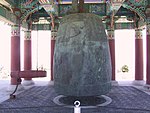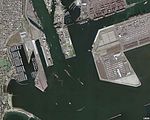Old St. Peter's Episcopal Church
19th-century Episcopal church buildingsCarpenter Gothic church buildings in CaliforniaChurches completed in 1883Churches in Los AngelesChurches in San Pedro, Los Angeles ... and 3 more
Episcopal church buildings in CaliforniaLos Angeles Historic-Cultural MonumentsVictorian architecture in California

Old St. Peter's Episcopal Church is a Los Angeles Historic-Cultural Monument located in the San Pedro section of Los Angeles, California, near the Port of Los Angeles. Built in 1883 in the Carpenter Gothic Victorian architecture style, it is San Pedro's oldest church.
Excerpt from the Wikipedia article Old St. Peter's Episcopal Church (License: CC BY-SA 3.0, Authors, Images).Old St. Peter's Episcopal Church
South Grand Avenue, Los Angeles San Pedro
Geographical coordinates (GPS) Address Nearby Places Show on map
Geographical coordinates (GPS)
| Latitude | Longitude |
|---|---|
| N 33.722501 ° | E -118.290187 ° |
Address
South Grand Avenue 2398
90731 Los Angeles, San Pedro
California, United States
Open on Google Maps









